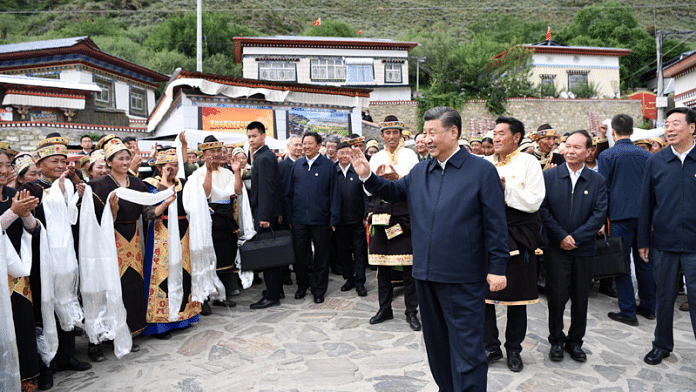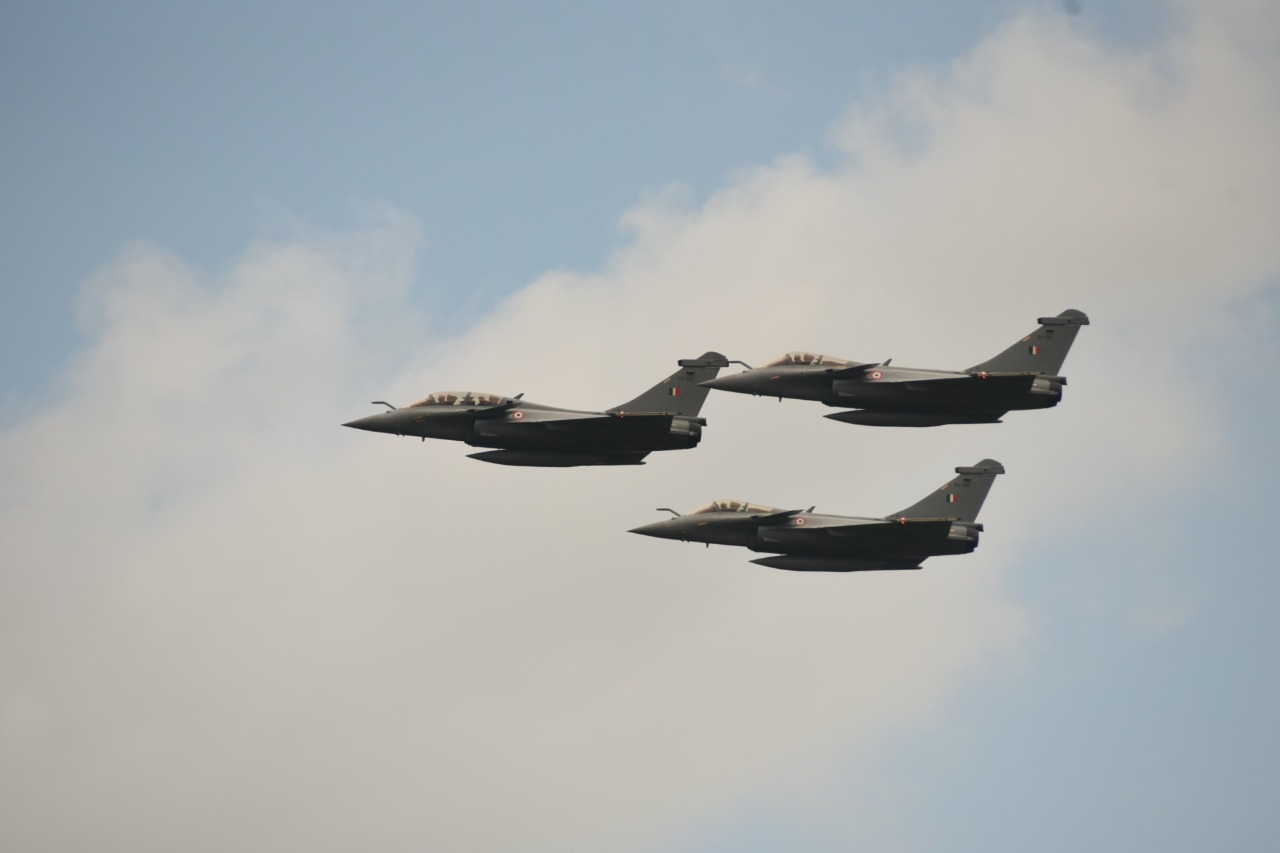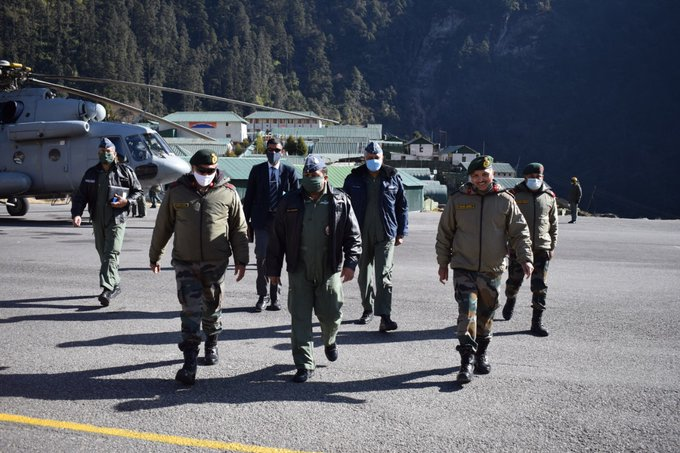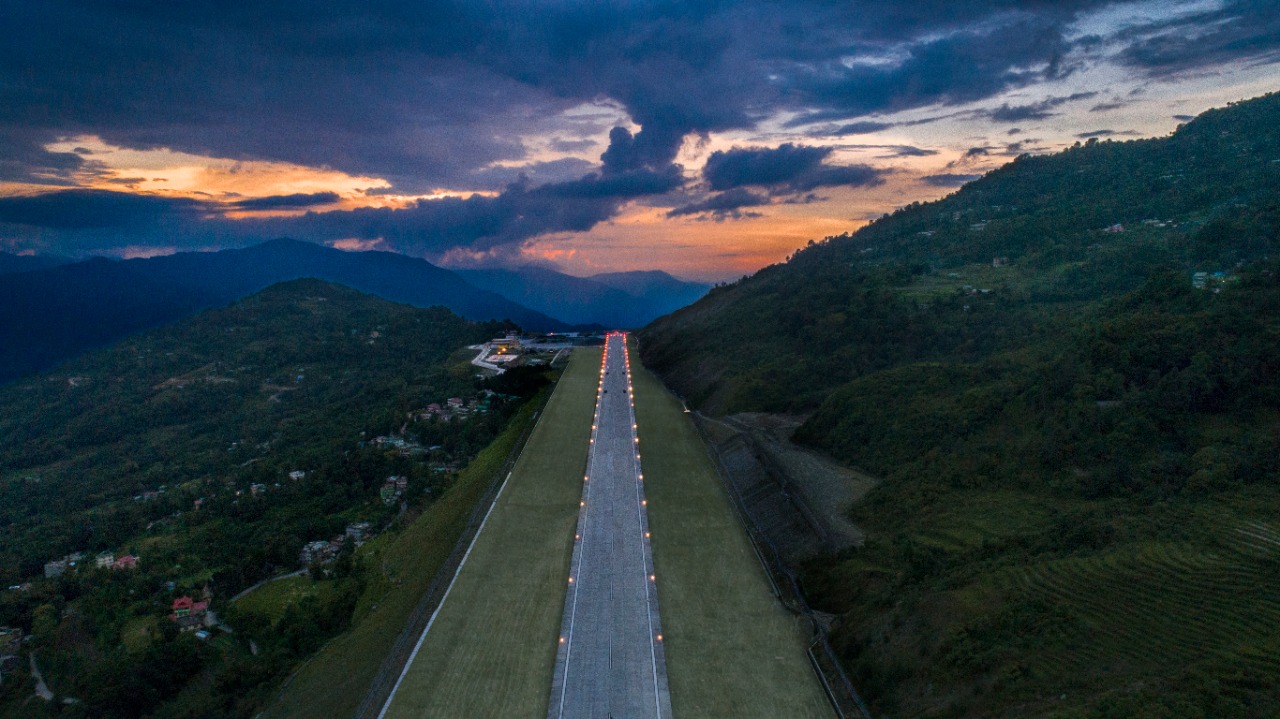There may not be a direct linkage between Chinese President Xi Jinping’s sudden tour last week to Tibet “without prior notice” and the Indian Air Force inducting Rafale fighter jets into the 101 Squadron of the Eastern Air Command (EAC) on July 28.
But what is significant is that while Xi, accompanied by three politburo members of his Communist Party and General Zhang Youxia, vice-chairman of the Central Military Commission, began his Tibet tour from Nyingchi Prefecture, which is just opposite India’s Arunachal Pradesh, the strengthening of the EAC through the induction of the Rafale is the recognition of its growing role.
The official Chinese maps include most of Arunachal within the administrative boundaries of Nyingchi Prefecture; it is also the place where the PLA Army is heavily deployed, with border defense regiments and missile bases.

The EAC safeguards the air space over a vast area that spans eight northeastern states, West Bengal, Bihar, Odisha, and Jharkhand, covering over 300,000 sq km. It also controls the air space over 6,300 km long international boundary with China, Nepal, Bhutan, Myanmar, and Bangladesh.
Video Of A Shiny, Shape-Shifting UFO Goes Viral, Sparks Debate Between Skeptics & Optimists – WATCH
EAC Is Sharply Focussed On China
Out of five operational commands of the Indian Air Force, three – Western Command, Central Command, and Eastern Command – deal with the Line of Actual Control (LAC) with China.
And of these three, the EAC, before the induction of the Rafale, had reportedly the maximum 101 fighter planes. Unlike the Western and Central Commands, which deal also with the borders with Pakistan, the EAC is believed to be mainly oriented against the threats from China.
So far, the EAC was mainly manned by SU-30MKI/MKI3 and MiG-27M fighters, AN-32 and Mi-series (8 and 17) transport/reconnaissance helicopters, Lockheed Martin C-130J Super Hercules turboprop military transport aircraft, HALChetak, and CH-47 Chinook strategic airlifters. Rafale is said to further sharpen the EAC’s teeth.

A recent report on the India–China military balance, “The Strategic Postures of China and India,” written by Frank O’ Donnell and Alexander K. Bollfrass, researchers at the Harvard Kennedy School suggests that the IAF’s current inventory of fourth-generation fighters (Mirage-2000s, MiG-29 UPG — used by the western command — and SU-30 MK and now Rafale — used by the western command — are more than a match for the PLA Air Force’s SU-30s, J-10s and J-11s.
It adds that given its battle proficiency and flexibility, the IAF is the only service that can apply asymmetric combat power and withstand the much-feared barrage of SSMs from the PLA Rocket Forces.
However, Air Vice Marshal (Dr) Arjun Subramaniam (Retd), a fighter pilot and military historian, is not so sure.
Given the rapid pace at which the Chinese PLA Air Force is increasing the number of the squadrons and bringing out new platforms like the early fifth-generation J-20 and J-31, it will overcome the present edge of the IAF even if the latter manages to acquire the planned 114 Multirole Fighter Aircraft (MRFA) with high-end fourth-generation capability and the indigenous LCA MK-1A and MK-2.
India cannot match the Chinese pace because of its budgetary constraints.
The best it can do is to quicken the production by the Hindustan Aeronautical Ltd of the planned fifth-generation Advanced Medium Combat Aircraft (AMCA) to neutralize the J-20 and J-31, he suggests, adding “the IAF must build offensive capability in both air-to-air and air–to-ground capability, supported by the latest generation of surveillance platforms—even if only to support defensive strategy to prevent the PLA from gradually shifting the LAC towards India.”
https://twitter.com/IAF_MCC/status/1420375697558675463
Of course, it is widely agreed that one thing India has done much better than China over the last seven years under the Modi government is in accelerating the infrastructure developments around the LAC.
China may be having numerical advantages in the platforms and ammunitions, but their ready availability and applications will be a little more time-consuming, given the infrastructural inadequacies.
Why India Has Edge Over China
Compared to China, India has more airbases and Advanced Landing Grounds (ALGs) near the LAC. In the case of China, the gap between the existing airbases close to the LAC is 400 to 500 Km. If it is a limited conflict across multiple high-altitude pressure points (and that is what military strategists believe will be the case, as both India and China will avoid a prolonged war), the IAF is expected to degrade and delay PLA’s troops–armor–logistics induction cycle across the LAC, supported by its heavy-lift platforms, e.g. the C-17 and IL-76, Chinooks and Mi-17 V5’s.
The C-130 J could assist rapid deployment at ALG such as Nyoma (Western Air Command), Fukche (Western Air Command), and Mechuka (Eastern Air Command).

Analysts say that Xi’s visit to the areas near the LAC last week should be seen, thus, in the context of his government’s determination to plug the gap by completing the defense infrastructure-related projects such as the 20 “general purpose” border airports and upgrade and extension of two additional highways along the LAC.
Financial constraints notwithstanding, the Modi government has improved the infrastructures near the LAC so that the Indian military achieves the technological and strategic edge over the adversary in terms of good quality metalled roads, railway tracks, bridges, tunnels, ALGs, and airbases.
India-China War: US Study Explains Why Indian Air Force Could Outgun China In A Border Conflict
Starting in 1999, out of 73 ICBRs (India-China Border Roads), less than 50 percent had been completed by the Border Road Organisation (BRO) by 2018. However, since 2018, with additional funds sanctioned, the speed of construction has increased exponentially.
Spending on LAC roads has tripled between 2016 and 2020, from $640 million to $1.7 billion. Some of the projects include the Darbuk-Shyok-Daulat Beg Oldie (DS-DBO) road and Rohtang Tunnel in Ladakh; the Sela Tunnel in the Northeast. In July 2020, the federal government also gave in-principle approval for the construction of a tunnel under the Brahmaputra to provide round-the-year connectivity between the northeastern states of Assam and Arunachal Pradesh.

Interestingly, the slow pace of the road construction near the LAC was explained by the BRO to India’s Parliamentary Standing Committee on Defence in this manner: “It would not be incorrect to say that a few years back the philosophy of our nation was that we should not make roads as near to the border as possible.
“That philosophy is telling today very clearly as to why we do not have roads. It is only a couple of years back that we suddenly decided a change of philosophy and said no, we must go as far forward as possible. It is going to take time. Unfortunately, the time cannot be compressed. Whatever we can do, it will take time.”
The point is that the previous philosophy was that the absence of border infrastructure would deny the invading forces access to the heartlands easily. That mindset has now changed.
Massive Infra Upgrade
With specific regard to the Air Force infrastructure, areas under the domain of the Eastern Air Command have seen maximum developments. As of 2020, all eight ALGs in Arunachal Pradesh at Vijaynagar, Pasighat, Mechuka, Walong, Tuting, Ziro, Along, and Tawang have been fully operationalized.
‘Magic Bricks’: Chinese Real Estate Firm Can Erect A Sturdy 10-Story Building In ONE Day — WATCH
The much-publicized Pakyong Airport in Sikkim, which was inaugurated by Prime Minister Narendra Modi on September 28, 2018, is now equipped with a 1.7 km-long runway capable of handling fighters and medium-lift military transport aircraft on the lines of Antonov An-32 and Lockheed Martin C-130J Super Hercules.

Bagdogra International Airport has been upgraded and Hasimara Air Force Station in north Bengal renovated, equipped with 2.7 km-plus long concrete and asphalt paved runways to serve as the crucial backbone of IAF’s airlift sorties.
While the Hasimara airbase is now hosting an entire Dassault Rafale squadron, Air Force Station Arjan Singh located at Panagarh in West Bengal is also geared up with a 2.74 km-long asphalt runway capable of handling heavy-lift transport jets like the Ilyushin IL-76 and Boeing C-17 Globemaster.
Panagarh is also the headquarters of the 17 Mountain Strike Corps of the Indian Army. The IAF has deployed six mid-air refueling tankers at Panagarh, thereby boosting the range of Sukhoi-30 combat jets positioned at Chabua and Tezpur airbases in Assam.
As Taliban Sweeps Afghanistan, Its ‘Department Of Evil’ Sends Shivers Across The Female Subjects
While the EAC bases are well equipped with permanent structures and paved runways, the focus has now shifted towards further upgrading the ALGs with concrete/ asphalt runways and the installation of night-landing facilities. The runway extension work at several airbases like in Bagdogra is also in progress to enable the operation of wide-bodied mid-air refuellers and transporters.
In sum, EAC (now headquartered at Shillong) has come a long way since its formation in 1959. So far it has had a reputation of being the “Mecca of fighter training”. But now, it is expected to show its worth in real operations against China if and when needed.




